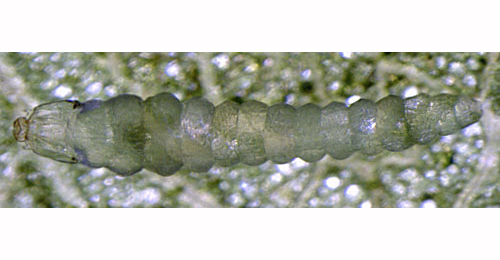|
||||||
|
FORSYTHIA. Golden-bell and Forsythia. [Oleaceae]
|
|
One species snd one hybrid of Forsythia are recorded in Britain. Two British miners are recorded on Forsythia. A key to the European miners recorded on Forsythia is provided in Bladmineerders van Europa. |
|
Key for the identification of the known mines of British |
1a > Leaf-miner and case-bearer: The larva feeds by inserting its head into small mines it creates on the leaves of birch, elm, alder, or hazel. Occasionally it is found feeding on other trees, or on herbaceous plants onto which it has accidentally Fallén. It forms two cases during its larval life. The first case is initially curved, smooth, laterally compressed with a bivalved anal opening, and about 2 mm long in September. During October it feeds, and adds a few rough collars of larval material around the oral opening. After hibernation, it feeds again in April and early May, adding more protruding collars until they equal or exceed the original smooth part of the case. At the same time, it expands the case girth by the creation of a silk gusset ventrally. The second case, 6 or 7 mm long, is formed in May, leaving the vacated first case attached to its last feeding mine. The new case is tubular with a trivalved crimp at the anal opening. The dorsum is formed from the edge of the leaf from which the case was cut. This results in a more or less serrated dorsal keel, depending on the plant species and the individual piece of leaf used. Considerable variation in the degree of serration can be found, even among specimens off the same tree. The case colour varies with food plant, from yellowish brown on birch, darkening through elm and hazel to dark brown on alder. The strongly curved young case is is a composite leaf case, the adult case is a tubular leaf case. The adult case is bivalved, about 7 mm in length; the mouth angle is around 30°. The case is straw coloured and almost always has a toothed dorsal keel (remnant of the margin of the leaf from which the case was cut). Neither larvae or cases of C. coracipennella, prunifoliae, serratella and spinella can be separated; from serratella. |
|
Coleophora serratella (Linnaeus 1761) [Lepidoptera: Coleophoridae]. |
1b > Leaf-miner, but not a case-bearer: Larvae usually gregarious. Early mine an epidermal gallery leading to a contorted blotch with black frass. Subsequently two successive cones formed by folding the tip of a leaf downwards (British leafminers, as Caloptilia syringella). Often, many leaves on a single bush turn brown and curl up with the mines. The species can be a pest in gardens. The mine begins at a row of eggs along the midrib. The emerging larvae form relatively broad, inconspicuous, lower-surface corridor. Subsequently a large, grey brown or greenish brown, very opaque upper-surface blotch is made, occupied by ten or more larvae. The mine makes the leaf somewhat bumpy, but the leaf does not fold around the mine, like in Caloptilia cuculipennella. After some time the larvae leave the mine and continue feeding, still comunnally, in a downwards rolled leaf. |
 Gracillaria syringella larva Image: © Willem Ellis (Bladmineerders van Europa) |
|
Gracillaria syringella (Fabricius, 1794) [Lepidoptera: Gracillariidae]. |
| Last updated 05-Jul-2019 Brian Pitkin | ||
